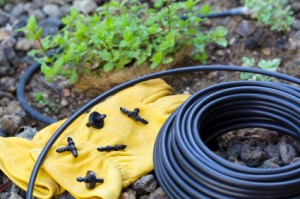
by Chantal DeYoe
A drip irrigation system can be as simple or as involved as you’d like it to be.
Regardless of the complexity, just about any source of water will suffice: the outdoor spigot, a well, ponds or rivers, and rainwater. You will, however, need to consider two very important components of water quality for any source of water you use: contaminants and debris, including organic matter.
Contaminants are microorganisms such as viruses, parasites, and bacteria; excessive amounts of chemical elements such as iron and chlorine; and chemical compounds that are present due to run-off from farm and industrial settings.
Any previously unused water source should be tested for contaminants. Your local extension office or health department can provide you with a good source for water testing. In the event that serious contaminants are discovered, you will need to deal with those prior to utilizing the water source for anything.
Debris is simply larger pieces of material that can be filtered out. Sand and algae are common and must be dealt with for a drip irrigation system to function properly on a long-term basis.
Filters come in a variety of styles. The simple screen filter is fine when you are using a clean water source, but if you are using dirty water, such as any kind of surface source, you will want a media filter. The media filter passes the water through a medium, usually sand, in order to remove debris. Another type of filter, the disk, is a cross between the screen and media and removes both debris and organic matter. The cartridge filter is a variation of the other types and is usually replaced rather than cleaned. Finally, you can use a centrifugal filter if you have a lot of sand in your water.
No matter what source of water you use, you will need to be able to move it from that source to your plants. If you use a municipal water supply, you will be able to hook your system directly to a spigot, a main water supply, or a converted sprinkler system. A well can function the same way.
If, however, you pull water from a natural body such as a pond, river, or lake, you will need to include a pumping system in your set up. This is also true when you use a holding tank or cistern. Very rarely will gravity suffice as a pumping mechanism for a drip irrigation system, no matter what the elevation of the holding tank. Pumps come in a variety of styles, sizes, and qualities, so this aspect of your system will require some research to determine what will work best for your needs. You can also check out solar-powered options.
While gravity cannot be depended on for the sum total of the pressure needed for your system, it is helpful to locate your holding tank at a somewhat higher elevation than your irrigated land if possible. It should also be on stable, level ground.
Once you’ve determined your water source, chosen a holding tank set-up, and researched pumping options, it’s time to lay out the system itself. It consists of two parts: drip zone assembly and drip tubing. The drip zone assembly consists of all the components that prepare your water source for application. The drip tubing is the mechanism that applies the water to your plants.
Within the drip zone assembly you will first have a controller for automatic operation. This piece of equipment turns the system on and off at set intervals. You can choose to operate the system manually if you like, but your system will conserve water most efficiently when the timing and duration of water application is carefully controlled.
Next comes the backflow prevention device, which is necessary if contamination of your water source is a concern. The backflow prevention device keeps contaminated water from “flowing back” into your main drinking water source, such as that provided by a municipal water company or a well.
If you choose to use irrigation-based fertilizer, that application device comes next. Then comes your filter. (In a two-part filter system, this would be the second filter.) And finally comes the pressure regulator. The pressure regulator converts high pressure water from your source to the lower pressure water required for your system. This is particularly important for municipal sources where the water pressure may be anywhere from 40 to 80 PSI (pounds per square inch). For well and surface water sources, you will need to determine the water pressure coming from your pump. Most drip irrigation systems operate between 20 and 30 PSI.
When planning your drip tubing layout, you will need to consider the types, layouts, and water requirements of your plants; soil type; linear footage requirements; and water supply. Water application occurs through emitters at each plant, or section of plants, depending your soil type. It is possible to have too many emitters, thus reducing your pressure at the end of the line. In addition, no single line should run more than 200 feet for the same reason. And finally, you will not be able to exceed your water supply, so plan your system to operate within the ability of your pump, holding tank, and source to supply your watering needs.
Whether you buy a kit or design your own, a drip irrigation system can improve your watering system.